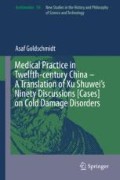Abstract
This case presents an interesting clinical phenomenon, a yin manifestation type in which the pulse is yang. Xu administers to the patient two rather odd elixirs. He does not explain why he used these unconventional medications. Adding to the complexity of the case is the fact that he notes the pulse after the patient took the two medications. At this point he explains the significance of these pulse types, which may have to do with the fact that the prescriptions did not have the desired effect. He then prescribes moxibustion.
Access this chapter
Tax calculation will be finalised at checkout
Purchases are for personal use only
Notes
- 1.
The Golden Fluid Elixir, which contains sulfur and realgar (雄黄), is recommended for deficiency of the kidney system yang with the major symptom of chronic cold sensations. It was used to cure impotence and involuntary loss of semen (shijing 失精). This elixir first appears in the Imperial Pharmacy’s formulary (Taiping huimin hejiju fang, juan 5, p. 105; Zengguang taiping huimin hejiju fang, p. 183). Xu Shuwei also records this elixir in case #69 below and in his formulary, Puji benshi fang, juan 9, p. 150.
- 2.
This elixir also first appears in the Imperial Pharmacy’s formulary (Taiping huimin hejiju fang, juan 5, p. 108; Zengguang taiping huimin hejiju fang, p. 190). Xu Shuwei records both elixirs in his formulary, Puji benshi fang, juan 9, p. 150.
- 3.
Moxibustion (jiu 灸 or aijiu 艾灸) is based on burning tinder, most commonly made of Chinese mugwort (Artemisia argyi or Artemisia vulgaris), next to an acupuncture locus or on it. The tinder is in the form of a cone which is placed on the skin. Moxibustion is designed to stimulate acu-points located on the body along specific circulation tracts in order to either alleviate local symptoms or, more generally, to affect the visceral system of functions and treat an underlying imbalance. For information concerning the Field of Cinnabar, see Zhongyi da cidian, 2nd ed., pp. 342.
- 4.
A similar though not identical discussion appears in Xu’s Shanghan fawei lun, p. 47.
- 5.
This quotation is taken from the Treatise (平脈法, line 21), Yu 1997, p. 25.
- 6.
Xu Shuwei discusses these three characters (翕奄沈) in detail in Puji benshi fang, juan 9, p. 150.
- 7.
See the identical wording in Maijing, juan 1, p. 506.
- 8.
This whole quotation, including the part from the Maijing, is taken from the Beiji qianjin yaofang, juan 28, p. 392.
Bibliography
Other Sources:
Yu, Bohai 于伯海, et. al. 1997. Shanghan jinkui wenbing mingzhu jicheng 伤寒金匮温病名著集成 [Collected Famous Works on Cold Damage, Golden Casket, and Febrile Disorders]. Beijing, Huaxia chubanshe.
Author information
Authors and Affiliations
Rights and permissions
Copyright information
© 2019 Springer Nature Switzerland AG
About this chapter
Cite this chapter
Goldschmidt, A. (2019). Case Number 51. In: Medical Practice in Twelfth-century China – A Translation of Xu Shuwei’s Ninety Discussions [Cases] on Cold Damage Disorders. Archimedes, vol 54. Springer, Cham. https://doi.org/10.1007/978-3-030-06103-6_52
Download citation
DOI: https://doi.org/10.1007/978-3-030-06103-6_52
Published:
Publisher Name: Springer, Cham
Print ISBN: 978-3-030-06102-9
Online ISBN: 978-3-030-06103-6
eBook Packages: MedicineMedicine (R0)

